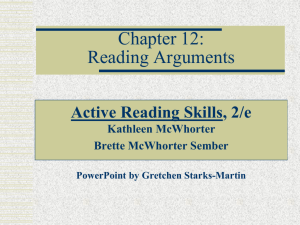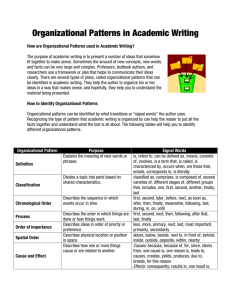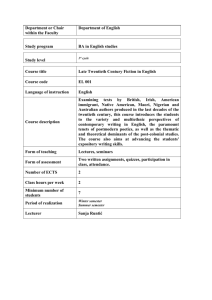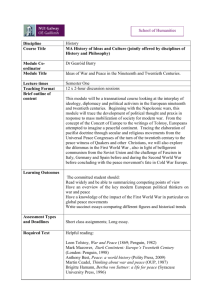The late twentieth century consensus
advertisement
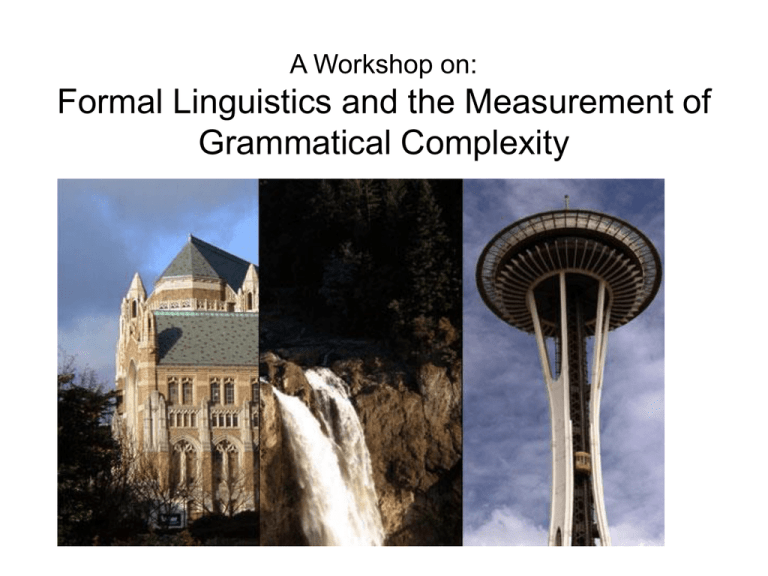
A Workshop on: Formal Linguistics and the Measurement of Grammatical Complexity WELCOME FROM Fritz Newmeyer, Workshop organizer Laurel Preston, Local organizer AND A BIG THANKS TO: The University of Washington Department of Linguistics The University of Washington Simpson Center for the Humanities The Mellon Foundation 2 TWO IMPORTANT COLLECTIONS ON COMPLEXITY Language complexity: Typology, contact, change, edited by Miestamo, Sinnemäki, and Karlsson (2008) Language complexity as an evolving variable, edited by Sampson, Gil and Trudgill (2009) 3 The late twentieth century consensus: All languages are equally complex “Again, one can isolate the complexity of a language in phonemics, in morphophonemics, in tactics, etc.; but these isolable properties may hang together in such a way that the total complexity of a language is approximately the same for all languages.” (Wells 1954: 104) Rulon Wells The late twentieth century consensus: All languages are equally complex “There are no ‘primitive’ languages — all languages are equally complex and equally capable of expressing any idea in the universe.” (Fromkin and Rodman 1983: 16) Victoria Fromkin 5 The late twentieth century consensus: All languages are equally complex “It is a finding of modern linguistics that all languages are roughly equal in terms of overall complexity.” (Dixon 1997: 118) Bob Dixon Why would anybody want to believe that all languages are equally complex? THREE REASONS: I. Humanism: Since all human groups are in a fundamental sense‘equal’, their languages must be ‘equal’ too. II. Language use: Complexity in one area will always be‘balanced out’ by simplicity in another area. III. Theory-internal considerations: The nature of UG demands that all languages be equally complex. 7 The late twentieth century consensus: All languages are equally complex Why would anybody want to believe that? I. HUMANISM Since language is the quintessential human cognitive faculty, to claim that human languages can differ in complexity is tantamount to claiming that human populations can differ in terms of their cognitive abilities. “…[S]ome people seem to think that if one language were shown to be more complex than another, then it would follow that the latter language is in some sense inferior, which in turn would entail that the speakers of that language are inferior, and from here we’re only one short step to ethnic cleansing.” (Gil 2001: 326) 8 The late twentieth century consensus: All languages are equally complex I sympathize with the humanistic argument, but I feel that it is deeply flawed: Any child can learn any language, whether it is ‘simple’ or ‘complex’. So a ‘simple grammar’ — if such a thing exists — does not imply a simple mind. Most discussions about complexity focus on morphology. What might a simple versus a complex morphology reveal about cognition? Probably nothing. 9 The late twentieth century consensus: All languages are equally complex Why would anybody want to believe that? II. THE CONSTRAINING EFFECTS OF LANGUAGE USE The constraints of language use ensure that language change be a series of ‘trade-offs’, keeping overall complexity in balance. This is a very old idea. 10 The late twentieth century consensus: All languages are equally complex “. . . the means of formal expression are of the utmost variety; they are not to be sought in one department of a language only, but in all; they are scattered through the whole vocabulary, as well as concentrated in the grammatical apparatus. Deficiency in one department may be compensated, or more than compensated, by provision of resources in another.” (Whitney 1875/1897: 222) 11 The late twentieth century consensus: All languages are equally complex SOME APPARENT COMPLEXITY TRADE-OFFS: Case marking tends to correlate with flexible word order (Siewierska 1998). Consider the history of most Indo-European languages, which have lost much case marking, but have developed more rigid order. Anna Siewierska 12 The late twentieth century consensus: All languages are equally complex Tomorrow Kaius Sinnemäki will discuss the tradeoffs between case marking and word order. Kaius Sinnemäki 13 The late twentieth century consensus: All languages are equally complex SOME APPARENT COMPLEXITY TRADE-OFFS: Complex syllable structure correlates with low tonal complexity (Matisoff 1973). James Matisoff The late twentieth century consensus: All languages are equally complex SOME APPARENT COMPLEXITY TRADE-OFFS: Languages that are spoken faster (i.e., that have a higher syllabic rate) tend to pack less information into each individual syllable (i.e., they have a lower information density). So information rates tend to be similar from language to language (Pellegrino, Coupé, and Marisco 2011). François Pellegrino 15 The late twentieth century consensus: All languages are equally complex And tomorrow Hisao Tokizaki will argue that trade-offs between phonology and morphosyntax follow from Universal Grammar. Hisao Tokizaki 16 The late twentieth century consensus: All languages are equally complex An important point: The existence of trade-offs allows for subparts of grammars to differ in complexity. 17 BUT ARE THERE ALWAYS TRADE-OFFS? Perhaps not: Elfdalian (a regional language of Sweden) is more complex than Standard Swedish by many criteria (Dahl 2004; 2009). A few examples: • E has more sandhi phenomena, stressed syllable types, and pitch accent types than SS. • E has more case, number, and declension types than SS. • E has person and number distinctions on the verb; SS has none. • E has lexically determined case and restricted pro drop; SS has neither. Östen Dahl BUT ARE THERE ALWAYS TRADE-OFFS? Perhaps not: According to Gil (2007; 2008; 2009), Riau Indonesian is simple in every component: There is (almost) no word-internal morphological structure, distinct syntactic categories, or construction specific rules of semantic interpretation. Gil claims that Riau does not have more complex rules of semantic interpretation to compensate for its simple morphosyntax. David Gil 19 BUT ARE THERE ALWAYS TRADE-OFFS? Perhaps not: Everett (2005) claims that Pirahã lacks recursion, quantifiers, numbers, colour terms, and much more. Pirahã has a complex morphology, but it is not clear how that would be a ‘tradeoff’ for the other things that the language lacks. Dan Everett 20 The late twentieth century consensus: All languages are equally complex Why would anybody want to believe that? III. THEORY-INTERNAL CONSIDERATIONS If languages are biologicallydetermined organs, like the liver or pancreas, then how could they differ in complexity?: “Similarly, if we assume biologically determined guidance [in language acquisition], we need to assume that languages do not vary in complexity.” (Moro 2008: 112) Andrea Moro 21 The late twentieth century consensus: All languages are equally complex And Denis Paperno will argue that if we assume Kolmogorov complexity, then, given the Principlesand-Parameters approach, all languages will be of equal complexity. Denis Paperno 22 What about Chomsky? The closest that Chomsky has ever come to claiming that all languages are equally complex: Noam Chomsky “If, say, a Martian superorganism were looking at us, it might determine that from its point of view the variations of brains, of memories and languages, are rather trivial, just like the variations in the size of hearts, in the way they function, and so on; and it might be amused to discover that the intellectual tradition of its subjects assumes otherwise.” (Chomsky 1980: 77) 23 But not all formal linguists conclude that all languages are equally complex See Progovac (2009) (and tomorrow’s talk) for an MP-based analysis of unequal complexity. Ljiljana Progovac 24 But not all formal linguists conclude that all languages are equally complex And given some versions of parametric theory, one can hypothesize that certain relations among parameters lead to more complex grammars. Biberauer, Roberts, Sheehan, and Holmberg will discuss this issue tomorrow. Theresa Biberauer Ian Roberts Michelle Sheehan Anders Holmberg And other formal frameworks have ways of handling differential complexity Peter Culicover will be presenting a construction grammar-based approach to complexity. Peter Culicover 26 THE MEASUREMENT OF GRAMMATICAL COMPLEXITY : VARIOUS APPROACHES TO MEASURING GRAMMATICAL COMPLEXITY Grammar-based : One measures and compares the degree of complexity of each grammatical component. User-based. One measures complexity from the point of view of the language user. First-language acquisition. Do some grammars (or parts of grammars) take longer for the child to acquire than others? Second-language acquisition. Do some grammars (or parts of grammars) take longer for the adult learner to acquire than others? Language use. Are some grammars (or parts of grammars) more difficult to use than others? 27 GRAMMAR-BASED COMPLEXITY McWhorter 2007: Complexity can be measured along three dimensions: Overspecification. The overt and obligatory marking of semantic distinctions. Structural Elaboration. The number of rules (in morphology, phonology, or syntax) or the size of inventories (functional categories, phonemes, etc.). John McWhorter Irregularity. 28 GRAMMAR-BASED COMPLEXITY By these criteria, Estonian is vastly more complex than Saramaccan Creole. 29 GRAMMAR-BASED COMPLEXITY Estonian genitive and partitive marking is much more semantically overspecified, structurally elaborate, and irregular than that of Saramaccan. Estonian has many more, and more irregular, morphophonemic processes than Saramaccan. 30 GRAMMAR-BASED COMPLEXITY Two presentations today will take a grammar-based approach: Ray Jackendoff David Gil and Eva Wittenberg GRAMMAR-BASED COMPLEXITY: POTENTIAL PROBLEMS DeGraff (2001): There has been no theory behind grammar-based complexity. Advocates write about ‘rules’, ‘phonemes’, ‘cases’, etc. without going below the surface. That is, the units of comparison are descriptive and intuitive terms, not the constructs provided by formal theory. Michel DeGraff 32 GRAMMAR-BASED COMPLEXITY Some objections The assumption guiding the idea that overspecification and structural elaboration makes things more complex seems to be that an obligatory distinction is necessarily more complex than an optional one. Why would one want to assume that? 33 GRAMMAR-BASED COMPLEXITY Some objections So compare English with Nez Perce (Deal to appear). Nez Perce does not distinguish morphosyntactically between modals of possibility and modals of necessity. By McWhorter’s criteria Nez Perce is less complex than English. Does that seem reasonable? The Nez Perce reservation In Idaho 34 GRAMMAR-BASED COMPLEXITY Some objections Grammar-based complexity approaches presuppose that the more one must convey, the more complex the system. By that criterion, a language with one 10,000-waysambiguous lexical item would be the least complex of all! 35 GRAMMAR-BASED COMPLEXITY: POTENTIAL PROBLEMS Grammar-based complexity is built on the assumption that complexity is necessarily overt. But certain types of grammars might pose more interpretive challenges than others. Walter Bisang (2009) argues that such is the case for Chinese and typologically similar languages. Walter Bisang 36 GRAMMAR-BASED COMPLEXITY: POTENTIAL PROBLEMS Tomorrow Lisa Matthewson will discuss whether languages can differ from each other in terms of their interpretive complexity. Lisa Matthewson 37 GRAMMAR-BASED COMPLEXITY: POTENTIAL PROBLEMS And Igor Yanovich will discuss this issue under the label ‘expressive complexity’. Igor Yanovich 38 USER-BASED COMPLEXITY: First-Language acquisition Do some grammars (or parts of grammars) take longer for the child to acquire than others? Dan Slobin (1982) compared children acquiring English, Italian, Serbo-Croatian, and Turkish at 4 age groups. Basically he found that the more form-meaning iconicity, the more rapid the acquisition. So Turkish children learned the morphology rapidly, but aspects of the syntax (e.g. relative clauses) relatively late. Dan Slobin USER-BASED COMPLEXITY: First-language acquisition A big problem here is that some elements of grammar are learned late, not because they are necessarily ‘more complex’, but because they belong to a stylistic register appropriate either to adults or to educated people or both. Along these lines: Dąbrowska (2010) showed that uneducated speakers of Polish and English master a number of constructions much later than educated speakers, or they do master them at all. The full Japanese honourific system is not learned until adulthood. 40 Little-used, late-learned, and ‘marginal’ aspects of the grammatical system Later today, Daniel Ross will discuss the relevance of such features for the measurement of complexity. Daniel Ross 41 USER-BASED COMPLEXITY: Second-language acquisition Do some grammars (or parts of grammars) take longer for the adult learner to acquire than others? Needless to say, one needs to abstract away from the degree of similarity of the L1 and the L2! But most work devoted to L2 focuses not on ‘absolute’ difficulty for L2 learners, but difficulty relative to some particular L1 (for an overview, see Herschensohn 2007). Julia Herschensohn USER-BASED COMPLEXITY: Language use Are some grammars (or parts of grammars) more difficult to use than others? That is not obviously the case. After all, all existing grammars are, by definition, ‘useable’. 43 USER-BASED COMPLEXITY: LANGUAGE USE Jack Hawkins (2004) has developed a way to measure the relative complexity of morphosyntactic constructions, but not the relative complexity of entire languages. John A. Hawkins 44 USER-BASED COMPLEXITY: LANGUAGE USE Hawkins’ principles: Minimize Domains. The larger the domain for a processing assignment, the more complexity. Minimize Forms. The more formal complexity of a form to be processed, the more processing complexity. Maximize On-Line Processing. The fewer properties that can be assigned to each item X as X is processed, the more complexity. 45 USER-BASED COMPLEXITY: PRESENTERS OF PROCESSING-ORIENTED PAPERS AT THIS WORKSHOP Markus Bader and Jana Häussler Constantin Freitag Andreas Trotzke 46 USER-BASED COMPLEXITY: What can we learn from neuroimaging studies? We’ll find out from Andrea Moro and from Lise Menn & Jill Duffield. Lise Menn & Jill Duffield 47 SOCIAL AND HISTORICAL FACTORS AFFECTING COMPLEXITY A long tradition maintains that different types of language contact and different types of language identity will affect language complexity. But there is no consensus at all about precisely how. 48 SOCIAL AND HISTORICAL FACTORS AFFECTING COMPLEXITY An old position (Bailey 1973; Traugott 1973; Sherzer 1977; Campbell 1980) is to say that: a.Internal language change involves simplification. b.Contact-induced change involves complication … c. … except for creolization, where pidgin speakers fall back on Universal Grammar (Givón 1979; Bickerton 1981). 49 SOCIAL AND HISTORICAL FACTORS AFFECTING COMPLEXITY The idea is that ‘left alone’, children will generalize rules, eliminate irregularity, and simplify their grammars wherever they can. So English has gradually reduced the number of irregular verbs over the years. Almost all of those that remain are high frequency. 50 SOCIAL AND HISTORICAL FACTORS Word order disharmonies are a good example of contact-induced complication (Harris and Campbell 1995): Amharic, originally VO, like most Semitic languages, borrowed OV and genitivenoun order from neighbouring Cushitic languages, but retained prepositions. Ahom (Thai) borrowed modifier-head order from Assamese (Indo-European) or some Tibeto-Burman language. Alice Harris Lyle Campbell SOCIAL AND HISTORICAL FACTORS But there are many examples (not involving creoles) where language contact has led to simplification (Thomason and Kaufman 1988): Asia Minor Greek lost /θ, đ/ (through merger with /t, d/) and grammatical gender through borrowing from Turkish. Sarah Thomason Terence Kaufman Ma’a lost such marked Cushitic features as ejectives, labialized dorsal phonemes, and the singulative number category through borrowing from 52 Bantu. SOCIAL AND HISTORICAL FACTORS And there are many examples of complication not due to contact. Consider grammaticalization, which can increase the number of categories in a language — which is usually taken to be a sign of increasing complexity: English has developed a separate category of modal auxiliaries. Romance and Germanic languages have developed new categories of indefinite articles from numerals and definite articles from demonstratives. 53 SOCIAL AND HISTORICAL FACTORS Grammaticalization can also increase the number of irregularities in a language: Three serializing verbs in Yoruba, ti ‘hold’, mú ‘take’, and gbà ‘get’, have acquired prepositional properties, but at different rates. So ti allows fronting of its complement, but mú and gbà do not. Ti and mú conjoin with verbs, but gbà does not (Givón 1975). Tom Givón 54 SOCIAL AND HISTORICAL FACTORS So are any generalisations possible regarding contact and complexity? The best worked out position is put forward by Peter Trudgill (2011). In a nutshell: Little contact (e.g. isolation) preserves complexity. Language varieties spoken in closed tight-knit societies tend to develop complexity. Language contact by adults decreases complexity. Language contact by children increases complexity. Peter Trudgill 55 SOCIAL AND HISTORICAL FACTORS: Support for Trudgill Icelandic and Faroese, due to their relative isolation, are more complex than Norwegian, which has experienced more contact, which itself is more complex in many ways than Danish. 56 SOCIAL AND HISTORICAL FACTORS: John McWhorter John McWhorter has argued at length that adult contact has led to simplification. As we have seen — he claims that creoles are simpler than non-creoles. In his view, English is simpler than other Germanic languages because of English L2 acquisition by Scandinavians in the Old English period. As a result, English has lost: • • grammatical gender marking on the article. most of its case morphology. 57 SOCIAL AND HISTORICAL FACTORS John McWhorter Complexity differences between related languages, according to McWhorter: Mandarin Chinese is simpler than other Chinese languages because of contact with Altaic speakers in the 1st century AD. Persian is simpler than other Iranian languages because of Persia’s non-Persian subjects trying to learn the language several centuries BC. Colloquial Arabic is simpler than Classical due to its spread over non-Arabic speaking areas. Malay/Indonesian is simpler than other Austronesian languages due to its use as a lingua franca. 58 SOCIAL AND HISTORICAL FACTORS John McWhorter NOTE: The L2 learners need not be politically dominant. So Dutch simplified to Afrikaans in South Africa, as a result of contact with Bantu and Koi-San speakers, even though it was the Dutch who dominated socio-politically. 59 SOCIAL AND HISTORICAL FACTORS Trudgill and McWhorter If Trudgill and McWhorter are right, then why are they right? Adult learners want things to be as simple as possible. Child learners don’t care. Small communities are characterized by more fast-speech phenomena, which lead ultimately to systemic complexity. Small communities develop complex systems in order to be opaque to their neighbours (Thurston 1994). 60 SOCIAL AND HISTORICAL FACTORS: Problems with Trudgill and McWhorter (Almost?) every Indo-European language has simplified its inflectional system over the past 2000 years — even low-contact isolated dialects. Why? 61 SOCIAL AND HISTORICAL FACTORS: Problems with Trudgill and McWhorter Lithuanian is said to be the most conservative Indo-European language, preserving much of the original I-E inflectional and accentual systems. But Lithuanian has hardly been ‘isolated’ — it has been in contact with Polish, German, Russian, Swedish, Belarusian, Latvian, and Yiddish throughout history. 62 SOCIAL AND HISTORICAL FACTORS: Problems with Trudgill and McWhorter English phonology became considerably more complex as a result of contact with Norman French (cf. more complicated word stress rules, a new voicing opposition with fricatives, new morphosyntactic alternations, etc.). Is this complexification predicted, given the nature of the contact? 63 SOCIAL AND HISTORICAL FACTORS: Problems with Trudgill and McWhorter Discussants to Trudgill (2004b) did not find a robust correlation between contact (or lack of contact) and size of consonant inventory. For example, Rice (2004) points out that Athabaskan languages tend to have complex consonant inventories regardless of the degree of contact with other languages. 64 SOCIAL AND HISTORICAL FACTORS: Problems with Trudgill and McWhorter Hay and Bauer (2007) have found that the more speakers a language has, the bigger its phoneme inventory is likely to be. Along the same lines, Campbell and Poser (2008) found no correlation at all between relative isolation of a language, population size, and complexity. So many small isolated languages, like Rotokas, Pirahã, Hawaiian, and Maori have very small phonemic inventories. While Quechua, Zulu, Georgian, and Arabic have millions of speakers and large complex phonemic inventories. 65 SOCIAL AND HISTORICAL FACTORS: Problems with Trudgill and McWhorter When McWhorter and Trudgill write about small or large population size, they equivocate on whether they mean ‘small’ or ‘large’ in absolute or relative terms. A language can have only 10,000 speakers, but still be much bigger than its neighbours (Sinnemäki 2009). Analogously, Nichols (2009) points out that many non-Western languages once had many more speakers than today, yet the complexity does not necessarily change as the number of speakers diminishes. 66 Thanks … and enjoy the next two days! 67


